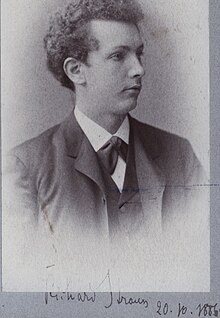1st Horn Concerto (Strauss)
The 1882/83 Concerto for French Horn and Orchestra No. 1 op. 11 in E flat major by Richard Strauss (1864–1949) was premiered in the orchestral version in 1885 with the soloist Gustav Leinhos under the conductor Hans von Bülow .
Origin and premiere
Franz Strauss , the father of Richard Strauss, was a well-known horn player and member of the Munich Court Opera Orchestra . So it made sense to write a solo work for the familiar instrument, which the 18-year-old Richard dedicated to "his dear father, Mr. Franz Strauss, royal Bavarian chamber musician" for his 60th birthday. Immediately after or during the composition of his violin concerto in 1882 he began the work and finished it in 1883 at the latest. Parallel to the first version with piano accompaniment, a version for horn and orchestra was also created in the winter of 1882/83, dedicated to the then principal horn player of the Royal Saxon Court Orchestra Dresden , Oscar Franz . The piano version was first heard publicly in the spring of 1883 in a concert by the Munich Tonkünstler Association with Bruno Hoyer and the composer himself at the piano. In the orchestral version, the 1st Horn Concerto was premiered on March 4, 1885 as part of a concert in Meiningen with the Meiningen court orchestra under the direction of Hans von Bülow and the soloist Gustav Leinho. In 1886 the concert was published by the music publisher Josef Aibl .
Around 60 years later, Strauss was to return to this genre of the instrumental concert with his 2nd Horn Concerto .
Cast and playing time
In addition to the solo horn, the score provides for the following scoring : 2 flutes , 2 oboes , 2 clarinets , 2 bassoons , 2 horns , 2 trumpets , timpani and strings .
The performance lasts around 16 to 19 minutes.
characterization
Musically, the 1st Horn Concerto is in the tradition of Mendelssohn and Weber . It is composed of 3 sets: Allegro - Andante - Allegro, but pass directly into each other and together form a single sonata form, in which the first Allegro as exposure , the Andante as implementation and the final Allegro as recapitulation functions. The latter is in the form of a rondo , the refrains and couplets of which vary the subject matter of the first movement. An ascending triole, derived from the main theme of the first movement, acts as a link . The cantable middle movement is in A flat minor (with an E major insert), the corner movements in E flat major.
literature
- Walter Werbeck (Ed.): Richard Strauss Handbook . Metzler / Bärenreiter, Stuttgart 2014, ISBN 978-3-476-02344-5 , pp. 448–449.
- Wulf Konold (Ed.): Lexicon Orchestermusik Romantik. SZ . Piper / Schott, Mainz 1989. ISBN 3-7957-8228-7 , pp. 932-933.
- Hansjuergen Schaefer (Ed.): Concert book orchestral music PZ. VEB Deutscher Verlag für Musik, Leipzig, 1974, pp. 410-411.
